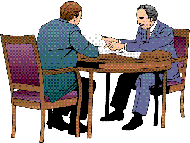 As this issue of NAATS
News was being finalized, Congress was closer to deciding next year's funding level
for the Department of Transportation and for the FAA. In particular, the House's modest
reduction in FY 1998 funding for OASIS was reversed by the Senate.
As this issue of NAATS
News was being finalized, Congress was closer to deciding next year's funding level
for the Department of Transportation and for the FAA. In particular, the House's modest
reduction in FY 1998 funding for OASIS was reversed by the Senate.
The OASIS money ($1 million) was cut by the House in the belief that previous delays in
the program meant that the full amount requested by the Administration ($4.9 million) was
not necessary at this time. However, NAATS' lobbyists was able to locate an appeal
document from the FAA showing that the $1 million cut in FY 1998 would have the effect of
costing the FAA up to $2.5 million in later years principally through increased
maintenance costs on M1FC equipment.
![]() After discussing their cut with House
appropriations staff, NAATS lobbyists briefed Senate staff shortly before their version of
the bill was to go to the Subcommittee for a vote. Happily, we were able to convince the
Senate that a $1 million cut in OASIS funding this year was "penny-wise and
pound-foolish." We expect the House to agree with the Senate's action when the two
meet later this summer to iron out the differences between the two bills.
After discussing their cut with House
appropriations staff, NAATS lobbyists briefed Senate staff shortly before their version of
the bill was to go to the Subcommittee for a vote. Happily, we were able to convince the
Senate that a $1 million cut in OASIS funding this year was "penny-wise and
pound-foolish." We expect the House to agree with the Senate's action when the two
meet later this summer to iron out the differences between the two bills.
 The SIR 2
calls for a multi step acquisition plan. The first Phase will be the installation of six
sites throughout the country with SEA as the first or key site. In this phase, dates are
referenced to months after award of contract. The agency is determined to hold to the
August 25, 1997 as the date for the contract.
The SIR 2
calls for a multi step acquisition plan. The first Phase will be the installation of six
sites throughout the country with SEA as the first or key site. In this phase, dates are
referenced to months after award of contract. The agency is determined to hold to the
August 25, 1997 as the date for the contract. I was privileged to be invited and to attend
and address the PASS convention in Las Vegas on June 5. The convention theme recognized
their 20 years as a federal sector labor union. I congratulated them and stressed the
importance of our continuing to work together on common issues. I also had the opportunity
to discuss a number of matters with PASS President Jack Johnson and NATCA Vice President
Mike McNally. We all agreed that we have much to gain by pooling our efforts when
appropriate.
I was privileged to be invited and to attend
and address the PASS convention in Las Vegas on June 5. The convention theme recognized
their 20 years as a federal sector labor union. I congratulated them and stressed the
importance of our continuing to work together on common issues. I also had the opportunity
to discuss a number of matters with PASS President Jack Johnson and NATCA Vice President
Mike McNally. We all agreed that we have much to gain by pooling our efforts when
appropriate.  PASS members and
representatives frequently ask whether a particular dispute with the FAA or DOD should be
filed with the FLRA as an unfair labor practice or under the collective bargaining
agreement as a grievance. Although in most cases the answer is clear, the issue becomes
somewhat complicated when the subject matter of the dispute is related to an article in
the collective bargaining agreement.
PASS members and
representatives frequently ask whether a particular dispute with the FAA or DOD should be
filed with the FLRA as an unfair labor practice or under the collective bargaining
agreement as a grievance. Although in most cases the answer is clear, the issue becomes
somewhat complicated when the subject matter of the dispute is related to an article in
the collective bargaining agreement.  Hello everyone. I wasn't
going to write an article for the newsletter this month. Then I just received word that
Ms. Gina Pickering, NAATS NFP National Coordinator has been selected for a supervisor
position at FTW AFSS. So I have two things to discuss with you.
Hello everyone. I wasn't
going to write an article for the newsletter this month. Then I just received word that
Ms. Gina Pickering, NAATS NFP National Coordinator has been selected for a supervisor
position at FTW AFSS. So I have two things to discuss with you.